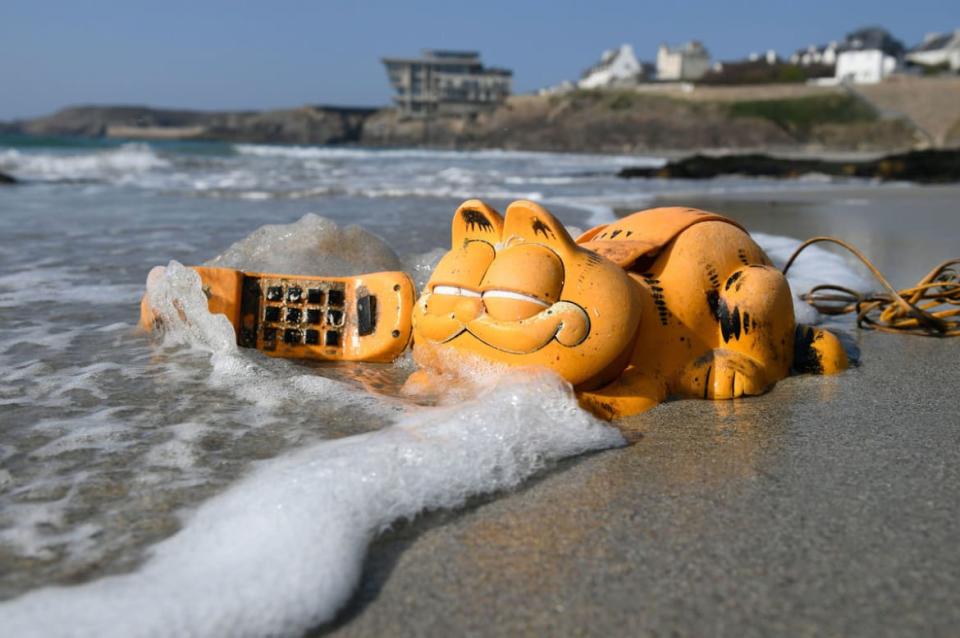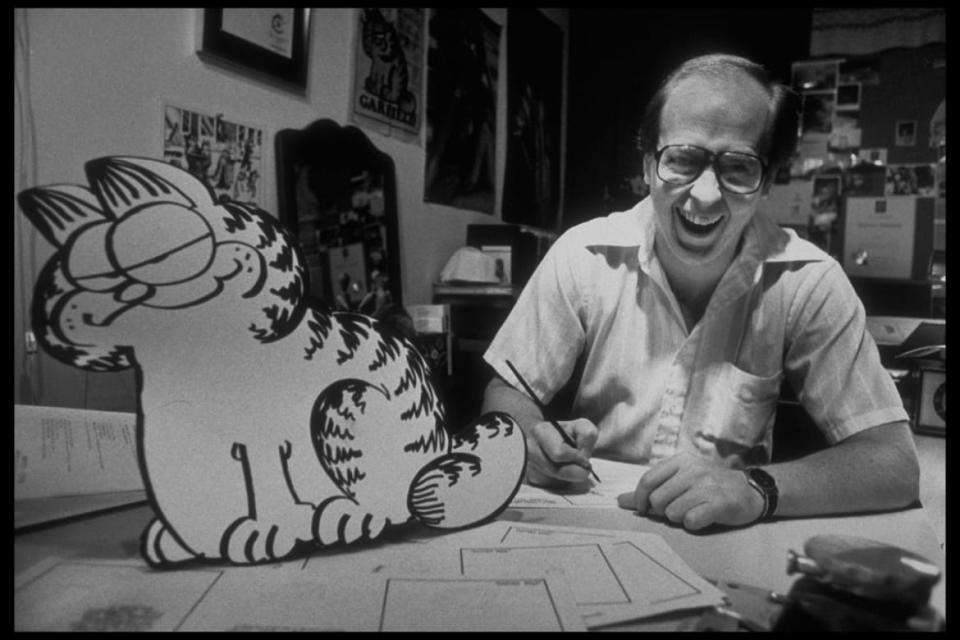Garfield: A Fat, Lazy Cat Who Is the Epitome of America

For decades now, French beaches have weathered a strange kind of plague. Since the 1980s, shards of orange plastic phones have been washing ashore—relics of an old novelty phone forged in the shape of Garfield, the most beloved cat in the U.S. Just five years ago, the lost shipping container that had set these creatures loose was found in a cave. Unfortunately, it was already empty—meaning, as far as this ongoing environmental issue was concerned, the cat was already out of the bag.
As absurd as the image of French beachgoers stumbling on an endless tide of Garfield phones might be, it also feels deeply symbolic. Love him or hate him, Garfield is inescapable. As far as comics go, he’s America’s biggest export: Guinness World Records has Garfield on record as the most-syndicated comic across the globe. Put his face on anything, and it’ll fly off the shelves. Just ask his creator, Jim Davis, who actually stopped selling those suction-cup Garfield plushies for five years following their initial debut because after just two years, they’d sold so well (to the tune of 225 million plush cats) that he feared overexposure. America’s national bird might be a bald eagle, but if we could elect a mascot, this fat cat would win by default.
As longtime fans know, this week’s new Garfield movie is just the tip of the furry iceberg when it comes to this cat’s cultural empire. There’s the original syndicated comic, the book compilations, 12 (twelve!!!) TV specials that helped save primetime cartoons, the unforgettable TV series Garfield and Friends (which taught a certain subset of millennials, including yours truly, about the joys of sarcasm), Garfield’s Pet Force (both the 2009 movie and the early-reader Scholastic novel series), and, of course, the live-action 2000s movies starring Bill Murray. No matter what your preferred medium might be, this orange tabby has probably already infiltrated it.
Garfield is not a difficult guy to understand. He hates Mondays. He loves lasagna. His favorite pastime (besides sleeping) is gently humiliating his owner, the lonely bachelor Jon Arbuckle. He’s apolitical, both because Davis himself admits that his grasp of politics “isn’t strong” and because he is a cat. In other words, it’s easy to relate to Garfield because he is the id incarnate—a creature living free of the social mores and taboos that define human existence. Garfield is everything and nothing, a perfect vessel for all of our human impulses, anxieties, and frustrations. It’s no wonder that since he first debuted in 1978, he’s sold like gangbusters, even though a considerable segment of the population really hates him.

A Garfield phone on the beach of Le Conquet, in western France
More than anything, the Garfield movies—all of which seem to perform their tails off at the box office despite bad reviews—might be the best lens through which to understand this precocious puss’s staggering success.
To say that Bill Murray’s Garfield movies were not well received in the 2000s would be laughable enough to make someone cough up a hairball. The first of those movies, 2004’s Garfield: The Movie, sports a dismal score of 14 percent on Rotten Tomatoes. The BBC called it a “cat-astrophic caper”—a “misguided attempt to construct a feature-length vehicle around a cartoon creation who was barely tolerable over three panels.” As The Austin Chronicle put it, “You’d have to be a real asshole to hate this movie, loaded as it is with adorable animals. Sadly the task falls to me.”
Nevertheless, Garfield persisted with the sequel, Garfield: A Tail of Two Kitties, two years later—one that somehow did worse with critics. Maybe that’s because in spite of all the withering pans, Garfield: The Movie managed to quadruple its budget in worldwide box office, according to Box Office Mojo. Relatively speaking, A Tail of Two Kitties did not fare much worse. Haters can grouse all they want, but anyone who sleeps on Garfield clearly does so at their own peril.

Jim Davis
Now, the new entry The Garfield Movie—which stars Chris Pratt as the titular feline—seems poised to repeat history. It’s already scratched out a win at the box office in spite of less-than-stellar reviews, and with debuts still to come in several key markets, its ticket sales only seem poised to grow. That, my friends, is the power of Garfield—our cynical capitalist king.
While the Garfield movies illustrate this cat’s ridiculous commercial power, he’s really scratched into our collective psyche online, where Garfield memes have basically become sacred texts. As someone who once dated two men in the same summer who owned the same Neon Genesis Evangelion Garfield T-shirt (that’s Brooklyn for you, baby!) I’ll admit I’ve long had a vested interest in figuring out how the hell this cat’s face seems to end up in the most idiosyncratic places. The answer, it seems, is the very thing that makes so many people hate him—the vague, punchline-free nature of his world.
‘The Garfield Movie’ Wastes His Ninth Life
The core of Garfield’s appeal, beyond his aggressive relatability, might be the anodyne emptiness of the comics themselves. Jon’s life seems utterly sad—almost completely devoid of things to do, places to go, and people to see. The comics technically take place in Muncie, Indiana, but really, Garfield and his owner could live anywhere. The lack of context makes this comic strip malleable fodder for memes. Jon’s sadness is our sadness. His existential dread is our existential dread.
Before meme culture took off in earnest, Garfield Minus Garfield creator Dan Walsh tapped into the inherent tragedy of Jon’s existence by removing Garfield from individual comic strips—which often leaves Jon talking to no one about, like, his hamburger. Walsh has continued the gambit for more than a decade now, continuing what will likely always remain the internet’s most famous Garfield joke. Over time, however, the memes have gotten significantly darker (and, in some cases, more political).
For years now, the subreddit r/imsorryjon has churned out some of the creepiest Garfields you’ll ever see. (The genre for this particular kind of Garfield meme is, appropriately, “Gorefield”—the idea being that Garfield is a horrific beast who exists to torture Jon.) Some twisted artists have slapped Garfield’s face onto creatures from Alien; some have given him fangs; some leave him looking perfectly normal but mourning “the eternal damnation of mankind.” From sketches of a mutant Garfield bursting out of Jon’s abdomen to Garfield breaking into SpongeBob SquarePants’s brain to turn him into a Leona Lewis fan, this page truly has everything. Meanwhile, r/GarfieldMemes has largely died down, but some of the archival posts are equally bleak.
At this point, it’s clear that Garfield can become the face of just about anything. His face is synonymous with capitalist supremacy, and at the same time, an entire Etsy marketplace exists for leftist Garfield merch. In many cases, the irony is likely intentional, and it also illustrates precisely what makes Garfield such a distinctly American force of nature. Whether beloved or critically maligned, if you put his face on something, it’ll probably be gone by morning. He stands for nothing, and therefore, he can sell anything.
Get the Daily Beast's biggest scoops and scandals delivered right to your inbox. Sign up now.
Stay informed and gain unlimited access to the Daily Beast's unmatched reporting. Subscribe now.

 Yahoo News
Yahoo News 
